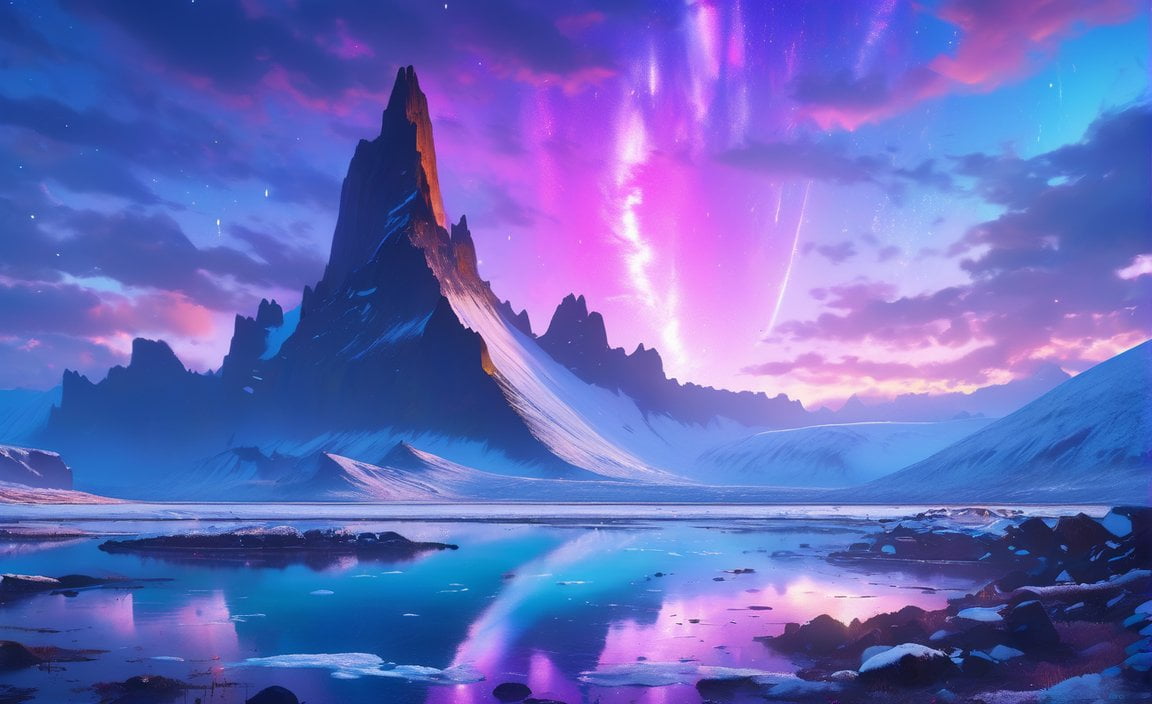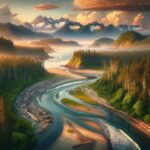Prepare to embark on an extraordinary journey as we unveil the enchanting wonders of Iceland Coordinates. In this captivating exploration, we will delve into the mesmerizing beauty and the intriguing mysteries that await in this extraordinary country. With a seasoned travel journalist as your guide, experience the diverse landscapes, natural wonders, and rich history of Iceland. From the pristine glaciers to the vibrant geothermal springs, every aspect of this Icelandic adventure is meticulously curated for an unforgettable experience. Join us as we discover the hidden secrets of Iceland Coordinates and immerse ourselves in its unique allure.

Key Takeaways:
- Iceland’s coordinates can vary slightly depending on different sources.
- Commonly mentioned coordinates for Iceland are Latitude 64.963051 and Longitude -19.0208351.
- Other sources provide slightly different coordinates such as Latitude 64.55.52.59 N and Longitude -19.01.16.21 W, Latitude 65.00000000 and Longitude -18.000000003, Latitude 65° 00′ N and Longitude 18° 00′ W, and Latitude 64.9631° N and Longitude 19.0208° W.
- These coordinates are based on the geographic coordinate system, which uses latitude and longitude to identify any location on Earth.
- Additional sources for learning more about Iceland’s coordinates include geodatos.net, latitude.to, latlong.info, mapsofworld.com, and iceland.org.
Iceland Coordinates
In order to fully explore the captivating landscapes and natural wonders of Iceland, it’s important to understand its coordinates. The coordinates of Iceland may slightly vary depending on different sources, but they all utilize the geographic coordinate system, which enables the identification of any location on Earth using latitude and longitude.
Here are some commonly mentioned coordinates for Iceland:
- Latitude 64.963051 and Longitude -19.0208351 [^1]
- Latitude 64.55.52.59 N and Longitude -19.01.16.21 W [^2]
- Latitude 65.00000000 and Longitude -18.000000003 [^3]
- Latitude 65° 00′ N and Longitude 18° 00′ W [^4]
- Latitude 64.9631° N and Longitude 19.0208° W [^5]
The slight variations in these coordinates may be due to different measurement methodologies or reference points. Regardless of the specific values, they all pinpoint Iceland’s location on the Earth’s surface.
To dive deeper into the world of Iceland coordinates and explore different sources, consider visiting the following websites:
These sources will provide you with comprehensive information about Iceland’s coordinates, allowing you to better navigate and appreciate the beauty of this unique destination.
Understanding Latitude and Longitude
Latitude and longitude are the two components of the geographic coordinate system used to determine a specific location on Earth’s surface.
Latitude refers to the distance north or south of the equator, with 0 degrees being the equator itself. In the case of Iceland, it is located in the northern hemisphere, which means its latitude is in the positive values. The latitude coordinates for Iceland range from around 64.55° N to 65.00° N, depending on the source.
Longitude, on the other hand, represents the distance east or west of the prime meridian, which is located in Greenwich, London. For Iceland, the longitude values fall in the negative range, ranging from approximately -19.02° W to -18.00° W.
By understanding these coordinates, travelers can accurately locate Iceland on a map or navigation system, ensuring a smooth and enjoyable journey.
The Significance of Iceland’s Coordinates
Iceland’s unique coordinates contribute to its distinctiveness as a destination. The country is situated on the Mid-Atlantic Ridge, where the North American and Eurasian tectonic plates meet. This geological location makes Iceland a place of significant volcanic and geothermal activity, resulting in its stunning landscapes and natural wonders, such as geysers, hot springs, and volcanic landscapes.
Moreover, Iceland’s coordinates also influence its climate. Being located close to the Arctic Circle, the country experiences long summer days and extended winter nights. This unique geographical positioning sets the stage for awe-inspiring natural phenomena like the Northern Lights, also known as the Aurora Borealis, which are best viewed in the dark winter months when the country is plunged into darkness.
Planning Your Journey Based on Iceland Coordinates
Understanding Iceland’s coordinates can be immensely helpful when planning your journey to this enchanting country. By knowing the latitude and longitude of your desired destinations, you can efficiently navigate through Iceland’s diverse landscapes and make the most of your time.
For instance, if you’re interested in exploring Reykjavik, Iceland’s vibrant capital, knowing its latitude of around 64.13° N and longitude of roughly -21.82° W will guide you to this cosmopolitan city. If you’re more drawn to the famous Golden Circle route, which includes popular attractions like Thingvellir National Park, Geysir geothermal area, and Gullfoss waterfall, understanding the specific coordinates of each location will ensure you don’t miss a thing.
Iceland’s coordinates offer more than just navigation aids; they provide a glimpse into the country’s distinctive geography and geological wonders. It’s like having a roadmap to unlock the beauty and mystery of Iceland, guiding you to its hidden gems and helping you create unforgettable memories. So, embrace the coordinates, venture into the unknown, and let Iceland’s captivating landscapes and natural wonders amaze you.
Florida city on Tocobaga land – Florida city on Tocobaga land
Geography of ancient India – Geography of ancient India
Vermont state bird and flower – Vermont state bird and flower
State with most rivers – State with most rivers
The significance of Iceland’s positioning on the globe
Iceland is a country that holds a unique position on the globe, located at the confluence of the North Atlantic and Arctic oceans. This strategic positioning shapes Iceland’s geography, climate, and geological activity, contributing to its distinctiveness as a destination.
Iceland’s coordinates, Latitude 64.963051 and Longitude -19.0208351, pinpoint its location on the Earth’s surface. Latitude refers to the distance north or south of the equator, while longitude represents the distance east or west of the prime meridian. Understanding these coordinates offers a glimpse into Iceland’s geography and the wonders it holds.
The Geography of Iceland:
Iceland’s positioning on the globe influences its diverse landscapes, natural wonders, and intriguing history. Divided into eight geographical regions, including the Capital Region, Southern Peninsula, West, Westfjords, Northwest, Northeast, East, and South, Iceland offers a range of breathtaking sceneries.
The Highlands, comprising about half of Iceland’s land area, are mostly uninhabited and feature mountainous lava deserts. The Westfjords region, a large peninsula with numerous fjords, is home to Iceland’s northernmost glacier, Drangajökull. The Southern Peninsula, known as the Reykjanes Peninsula, showcases active volcanism and vast lava fields.
Iceland’s unique coordinates also contribute to its extensive volcanic and geothermal activity. The country lies along the rift associated with the Mid-Atlantic Ridge, where the Eurasian and North American tectonic plates meet. This geological phenomenon gives birth to stunning landscapes, including geysers, hot springs, and volcanic craters.
The Climate of Iceland:
Iceland’s positioning on the globe affects its temperate climate, characterized by cool summers and mild winters. The country benefits from the moderating influence of the North Atlantic Current, which brings relatively warm waters from the Gulf Stream. This current helps to mitigate Iceland’s high latitude, making its climate more hospitable than one might expect.
It is worth noting that Iceland experiences long summer days and extended winter nights due to its location close to the Arctic Circle. These unique aspects of Iceland’s climate contribute to its enchanting allure and offer travelers a chance to experience the wonder of the Midnight Sun or chase the elusive Northern Lights.
Key Takeaways:
- Iceland’s coordinates (Latitude 64.963051 and Longitude -19.0208351) pinpoint its location on the Earth’s surface, contributing to its distinctiveness as a destination.
- The country’s positioning at the confluence of the North Atlantic and Arctic oceans shapes its geography, climate, and geological activity.
- Iceland’s diverse landscapes, including uninhabited lava deserts, fjords, and volcanic fields, are a result of its unique coordinates and geological features.
- The country’s temperate climate, characterized by cool summers and mild winters, is influenced by the moderating effect of the North Atlantic Current.
- Iceland’s positioning near the Arctic Circle gives rise to long summer days and extended winter nights, providing opportunities to witness the Midnight Sun and the Northern Lights.
Sources:
1. Geography of Iceland – Wikipedia
2. Iceland – Country Profile – Nations Online Project
How coordinates impact navigation and travel in Iceland
In recent years, Iceland has become an increasingly popular destination for travelers seeking unique experiences and breathtaking landscapes. But when it comes to navigating this enchanting island, understanding how coordinates impact navigation is essential. In this article, we will delve into the significance of coordinates and how they influence travel in Iceland.
Navigating the Land of Fire and Ice
As an island country located in Northern Europe, Iceland’s coordinates play a crucial role in guiding travelers through its diverse landscapes and natural wonders. By utilizing maps, GPS systems, and a general understanding of their location, visitors can embark on an unforgettable journey across this captivating country.
1. Unveiling the Coordinates
Let’s start by shining a spotlight on the geographic coordinates of Iceland. Reykjavík, the country’s vibrant capital city, boasts a latitude of 64.128288 and a longitude of -21.827774. These coordinates act as a reference point for navigation and provide a starting point for exploring Iceland’s unique geography.
2. The Impact on Navigation
Understanding the coordinates of Iceland is fundamental for navigation. By having a general idea of your location and destination, you can use maps and GPS coordinates to navigate the country’s roads effectively. Whether you’re seeking the cascading waterfalls of Gullfoss or the breathtaking landscapes of the Highlands, having a grasp of your coordinates enables you to navigate with confidence.
3. Exploring Iceland’s Geography
Iceland’s coordinates are intricately linked to its geography, making it a destination like no other. Situated between the Greenland Sea and the North Atlantic Ocean, the country straddles the Eurasian and North American plates. This unique position contributes to its volcanic activity, geothermal wonders, and unparalleled landscapes.
The Mid-Atlantic Ridge, running through Iceland, gives rise to geysers, hot springs, and volcanic craters. From the lava deserts of the Highlands to the glacier-covered peaks of the Westfjords, each of Iceland’s eight geographical regions offers breathtaking sights and natural wonders that are inextricably shaped by its coordinates.
4. Planning Your Journey
When embarking on a journey in Iceland, knowing the coordinates allows you to plan your itinerary more effectively. By taking into account the distances between destinations and the specific coordinates of each location, you can optimize your travel route and make the most of your time in this awe-inspiring country. Whether you’re visiting Reykjavík’s vibrant cultural scene or venturing into the remote beauty of Akureyri, incorporating coordinates into your planning helps ensure a seamless and fulfilling adventure.
Key Takeaways:
- Coordinates play a crucial role in navigating and exploring the diverse landscapes of Iceland.
- Understanding Reykjavík’s coordinates (latitude: 64.128288, longitude: -21.827774) provides a starting point for exploration.
- Maps, GPS systems, and a general understanding of coordinates are essential tools for effective navigation in Iceland.
- Iceland’s unique geography, influenced by its coordinates, encompasses volcanic activity, geothermal wonders, glaciers, and breathtaking landscapes.
- Incorporating coordinates into your travel planning allows for an optimized itinerary, ensuring you make the most of your time in this captivating country.
- By embracing the significance of coordinates, travelers can embark on an unforgettable journey through the beauty and mystery of Iceland.
Sources:
– National Center for Biotechnology Information: link
– Wikipedia: link
Exploring the Unique Landscapes and Attractions at Different Coordinates in Iceland
When it comes to awe-inspiring natural beauty, Iceland is a destination like no other. Its diverse landscapes and unique attractions make it a paradise for those seeking adventure and exploration. From breathtaking glaciers to stunning waterfalls, Iceland has it all. In this article, we will delve into the wonders that await at different coordinates in Iceland.
A Journey through Iceland’s Remarkable Landscapes
Iceland’s coordinates play a significant role in shaping its geography, climate, and geological activity. This magical country, situated at the confluence of the North Atlantic and Arctic oceans, offers a multitude of landscapes that beckon travelers from around the world.
The Golden Circle and Beyond
One of Iceland’s most famous routes, the Golden Circle, showcases some of the country’s most iconic sights. At the coordinates Latitude 64.55.52.59 N and Longitude -19.01.16.21 W, you’ll find the powerful Gullfoss waterfall, the erupting geysers of the Haukadalur geothermal area, and the historical site of Þingvellir National Park, where the North American and Eurasian tectonic plates meet.
Venturing beyond the Golden Circle, you can explore the captivating Westfjords, known for their dramatic cliffs and fjords. At Latitude 65° 00′ N and Longitude 18° 00′ W, you’ll discover untouched nature and the chance to spot the northernmost glacier in Iceland, Drangajökull.
Snæfellsjökull National Park and Beyond
Heading to the coordinates Latitude 64.9631° N and Longitude 19.0208° W, you’ll encounter the mystical Snæfellsjökull National Park. This location inspired Jules Verne’s novel “Journey to the Center of the Earth” and offers breathtaking views of the Snæfellsjökull glacier and volcano.
Unveiling the Secrets of Iceland’s Unique Coordinates
Iceland’s coordinates not only serve as a guide for navigation but also provide insights into the country’s geography and geological wonders. By understanding these coordinates, travelers can optimize their itineraries and fully immerse themselves in Iceland’s beauty and mystery.
Latitude and Longitude: Unraveling the Puzzle
Latitude refers to a location’s distance north or south of the equator, while longitude represents its distance east or west of the prime meridian. These coordinates pinpoint Iceland’s location on the Earth’s surface, making it a captivating destination for explorers.
Influence on Climate and Natural Phenomena
Iceland’s geographic coordinates contribute to its distinctive climate. Its proximity to the Arctic Circle brings long summer days and extended winter nights, creating unique natural phenomena such as the Midnight Sun and the mesmerizing Northern Lights.
The Geological Battlefields
Iceland’s coordinates are closely tied to its geological activity. Situated along the rift associated with the Mid-Atlantic Ridge, the country experiences volcanic eruptions, geysers, hot springs, and volcanic craters. The Reykjanes Peninsula, featuring active volcanism and vast lava fields, showcases the fascinating interplay of Iceland’s coordinates and its geological wonders.
Key Takeaways:
- Iceland offers a multitude of unique landscapes and attractions waiting to be explored.
- The Golden Circle, Westfjords, and Snæfellsjökull National Park are must-visit regions in Iceland, each offering its own distinct beauty.
- Understanding Iceland’s coordinates helps with travel planning and navigating the country effectively.
- Iceland’s geographical location influences its climate and gives rise to phenomena like the Midnight Sun and the Northern Lights.
- The country’s geological activity is shaped by its coordinates, resulting in volcanic eruptions, geysers, and hot springs.
Sources:
1. The Adventures of Panda Bear – Unique Must See Landscapes in Iceland
2. Condé Nast Traveler – The 17 Most Beautiful Places in Iceland

FAQ
Q1: What are the coordinates of Iceland?
A1: Some commonly mentioned coordinates for Iceland are Latitude 64.963051 and Longitude -19.0208351, Latitude 64.55.52.59 N and Longitude -19.01.16.21 W, Latitude 65.00000000 and Longitude -18.000000003, Latitude 65° 00′ N and Longitude 18° 00′ W, and Latitude 64.9631° N and Longitude 19.0208° W.
Q2: How do the coordinates of Iceland impact navigation and travel?
A2: The coordinates of Iceland have an impact on navigation and travel in the country. They are important for travelers to effectively navigate and explore the diverse landscapes and attractions. It is recommended to have a general idea of your location and use maps and GPS coordinates to navigate the roads.
Q3: What are the major cities and landmarks in Iceland with their respective coordinates?
A3: The major cities and landmarks in Iceland with their respective coordinates are:
– Reykjavík: 64.13548, -21.89541
– Kópavogur: 64.11234, -21.91298
– Hafnarfjörður: 64.0671, -21.93774
– Akureyri: 65.68353, -18.0878
Q4: What is the area and coastline length of Iceland?
A4: Iceland has an area of 103,000 square kilometers and a coastline of about 4,970 kilometers.
Q5: What are some of the must-see landscapes in Iceland?
A5: Some of the must-see landscapes in Iceland include the Golden Circle route, Westfjords, Snæfellsjökull National Park, geysers, black sand beaches, lava fields, volcanic caves, and the largest glacier in the country, Vatnajökull.
- Unlock Elemental 2 Secrets: Actionable Insights Now - April 2, 2025
- Lot’s Wife’s Name: Unveiling the Mystery of Sodom’s Fall - April 2, 2025
- Photocell Sensors: A Complete Guide for Selection and Implementation - April 2, 2025
















